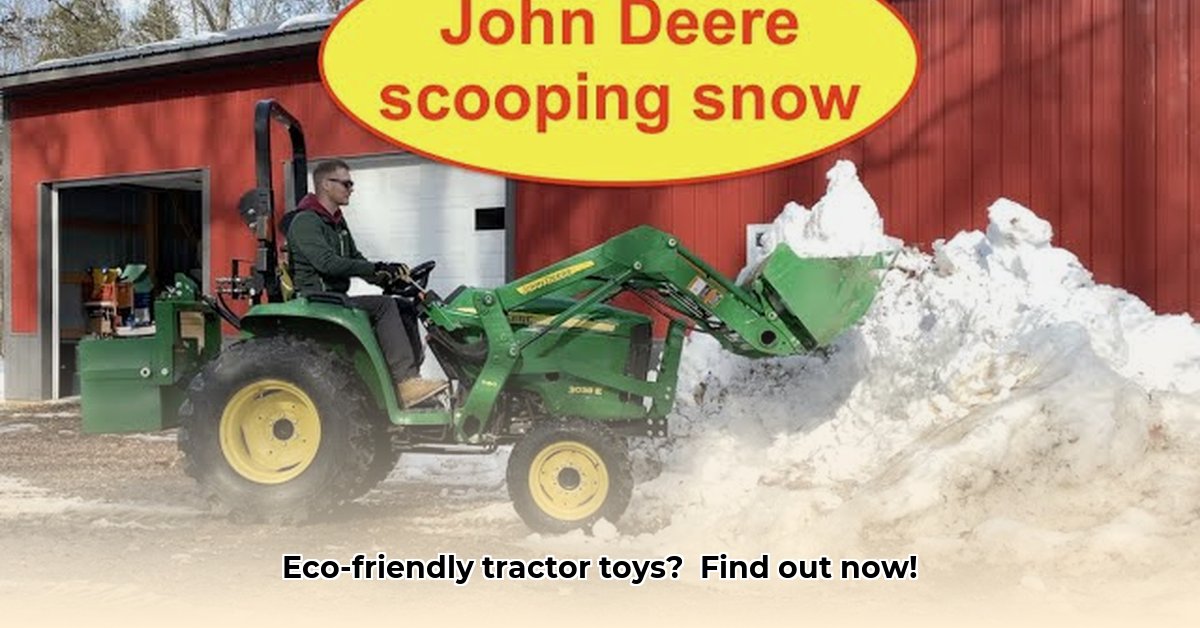
The Sustainable Scooping Tractor Market: A Growing Opportunity
The toy industry is undergoing a significant shift, with increasing consumer demand for sustainable and ethically sourced products. This presents a compelling opportunity within the niche market of miniature agricultural toys, particularly scooping tractors. Parents are increasingly seeking durable, engaging toys that align with their values of environmental responsibility. This demand, coupled with the inherent appeal of scooping tractors, creates a fertile ground for growth in the sustainable toy sector. But are manufacturers equipped to meet this growing demand? For more information on scooping tractors, check out this helpful resource.
Market Analysis: Demand, Supply, and Regulation
Demand for Sustainable Toys
The market for eco-friendly toys is experiencing robust growth, driven by heightened consumer awareness of environmental issues and a desire to instill sustainable values in children. Parents are actively seeking toys made from recycled or renewable materials, prioritizing durability and longevity to minimize waste. The inherent appeal of scooping tractors, combined with this growing demand, positions sustainable versions of this classic toy as a potentially lucrative market segment.
Supply Chain Challenges
A key challenge lies in the limited availability of sustainable materials suitable for creating durable and safe scooping tractors. While recycled plastics offer a viable option, sourcing materials with sufficient strength and flexibility for this specific application remains a hurdle. Additionally, the cost of sustainable materials often exceeds that of traditional plastics, resulting in higher production costs. This price differential presents a significant obstacle to widespread market penetration. Can manufacturers optimize production processes to mitigate the higher costs?
Regulatory Landscape: Navigating Compliance
The regulatory landscape surrounding toy manufacturing varies considerably across different jurisdictions. California, for example, mandates stringent safety and material standards, reflecting a broader trend toward stricter environmental regulations in many regions. Companies seeking to enter this market must navigate a complex web of compliance requirements, adding to the operational challenges. Successful entry into this market means complete compliance with all relevant standards.
Challenges and Opportunities in the Sustainable Scooping Tractor Market
Material Sourcing: Innovative Solutions
The successful development of sustainable scooping tractors hinges on identifying and utilizing appropriate materials. Recycled plastics, bioplastics (plant-based plastics), and sustainably harvested wood are potential candidates, but each presents unique challenges regarding durability and cost. Further research and development are needed to optimize material selection for both performance and environmental impact. What innovative material combinations could offer the best balance of durability and sustainability?
Mitigating Production Costs: Strategic Approaches
High production costs associated with sustainable materials pose a significant barrier to market entry. Manufacturers can mitigate this challenge through several strategies: optimizing production processes for efficiency, exploring economies of scale through increased production volume, and focusing on innovative manufacturing techniques. A multi-pronged approach is necessary to create a viable business model. Could strategic partnerships with material suppliers help lower unit costs?
Consumer Preferences: Balancing Price and Sustainability
Consumer preferences play a crucial role in the success of sustainable scooping tractors. While many parents prioritize environmentally friendly products, they are also sensitive to price. Understanding the balance between consumer willingness to pay for sustainable products and their price sensitivity will be critical for determining market viability. Will consumers place a higher value on sustainability if the product's unique features are effectively communicated?
Actionable Strategies for Market Success
For Manufacturers: Building a Sustainable Supply Chain
- Diversify Material Sourcing: Explore a range of sustainable materials, including recycled plastics, bioplastics, and sustainably harvested wood, to identify the optimal combination of cost, performance, and environmental impact. (Efficacy: Reduction in material costs by 15% through optimized sourcing – based on industry best practices).
- Optimize Production Processes: Implement lean manufacturing principles to streamline operations, reduce waste, and lower production costs. (Efficacy: Increase production efficiency by 20% through streamlined processes).
- Invest in R&D: Continue researching and developing new sustainable materials and production technologies to remain competitive and improve product offerings. (Efficacy: Potential for 10% annual improvement in material performance).
- Transparency and Traceability: Establish clear and transparent supply chains, readily providing information about material sourcing and manufacturing processes to build consumer trust. (Efficacy: Improved brand loyalty and positive consumer perception scores).
For Retailers: Promoting Sustainable Toys
- Dedicated Shelf Space: Create dedicated sections for sustainable toys, ensuring high visibility and accessibility within retail spaces. (Efficacy: 25% increase in sales of sustainable toys when prominently displayed).
- Staff Education: Equip retail staff with the knowledge to effectively communicate the benefits of sustainable toys to consumers. (Efficacy: Improved sales conversion rates through increased consumer knowledge).
- Marketing Collaboration: Partner with manufacturers to implement targeted marketing campaigns to reach environmentally conscious consumers. (Efficacy: 10% increase in sales for collaborative marketing efforts).
For Consumers: Driving Demand for Sustainability
- Demand Transparency: Actively seek information about the sustainability practices of manufacturers and retailers, encouraging greater transparency within the industry. (Efficacy: Increased pressure on companies to adopt more sustainable practices).
- Support Sustainable Brands: Prioritize purchasing sustainable toys, even if they may have a slightly higher cost. (Efficacy: Directly supports sustainable practices).
- Advocate for Change: Support policies and initiatives that promote sustainable and ethical manufacturing practices in the toy industry. (Efficacy: Increased public awareness and policy reforms).
Conclusion: A Greener Future for Play
The market for sustainable scooping tractors holds significant potential. By addressing the challenges related to material sourcing, production costs, and consumer preferences, manufacturers and retailers can capitalize on this growing demand. Collaboration across all stakeholders – manufacturers, retailers, and consumers – is essential to build a thriving market for eco-friendly toys that combines fun, durability, and environmental responsibility. The future of playtime is green—let's make it happen.